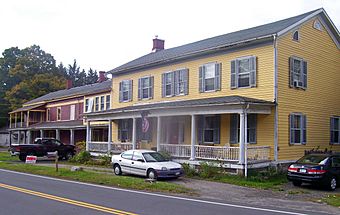Hoornbeek Store Complex facts for kids
Quick facts for kids |
|
|
Hoornbeek Store Complex
|
|

Store (left) and William Doll House, 2007
|
|
| Location | Napanoch, NY |
|---|---|
| Nearest city | Kingston |
| Area | 1 acre (0.40 ha) |
| Built | 1810; 1833; 1841 |
| Architectural style | Federal, Greek Revival |
| NRHP reference No. | 84003229 |
| Added to NRHP | 1984 |
The Hoornbeek Store Complex is a group of old buildings in Napanoch, New York, United States. It is listed on the National Register of Historic Places. This means it is an important historical site.
The complex sits on about one acre of land. It is located on Main Street in Napanoch. The buildings show how Napanoch changed over time. They also show how building styles changed. Early buildings were in the Federal style. Later ones used the Greek Revival style.
Contents
Exploring the Buildings
The Hoornbeek Store Complex has three main buildings. They were built over 30 years. Each building tells a part of Napanoch's history.
The William Doll House
The oldest building is the William Doll House. It was built around 1810. A local doctor and his family lived here. It was built in the Federal style. This style was popular in the early 1800s.
The house has five sections, called bays. It also has a special eight-panel front door. Inside, you can still see some original materials. Later updates, like the staircase, show the Greek Revival style. Today, the Doll House is still used as a private home.
The Hoornbeek Store
The Hoornbeek Store was built in 1833. It is located south of the Doll House. Richard and George Southwick built it. They bought land to benefit from the new Delaware and Hudson Canal. The canal opened five years earlier. It carried coal from Northeastern Pennsylvania to Kingston. From Kingston, coal went down the Hudson River to New York City.
The store shows the Greek Revival style. It has a front porch with five large pillars. It also has a big cornice (a decorative molding) and a tall frieze (a decorated band). In 1837, the store was connected to the Doll House. This happened when Doll bought the Southwicks' property. Later, in the 1900s, second-story porches were added. Today, the store building is empty.
The Napanoch Female Seminary
The last main building is the Napanoch Female Seminary. Gabriel Ludlum built it in 1841. He was renting the store from Doll at the time. This building is a simple two-story house. It is covered with clapboard siding.
Its windows are placed in unusual spots. This is because it was originally a girls' school. The schoolmaster lived on the ground floor. The students lived upstairs. At one point, this building was also connected to the store. This connection was removed in the 1900s.
Other Buildings on the Property
Around the main buildings, there are several smaller buildings. These are called outbuildings. They were used for services. For example, there was an ice house. There were also stables for horses. Other buildings included a wagon shed and a feed shed. These helped customers and residents.
A Look at the Past
The Hoornbeek Store Complex has a rich history. Many families owned and operated these buildings.
Early Owners and Operators
Gabriel Ludlum leased the store and house to John Decker and Eli DuBois. They ran the store as a combination of shops and a tavern. The house was used as a hotel. In 1864, Decker and DuBois bought the property. They fixed it up. Then, in 1867, they sold the house and store to the Hoornbeek family. The complex stayed in the Hoornbeek family for over 100 years. This is why it is known by their name.
The Hoornbeek Family Era
Calvin Hoornbeek used the complex for shops and apartments. When he died in 1890, his son L.D.B. Hoornbeek took over. L.D.B. continued the business. He lived in the house and ran the store. In 1925, he bought the seminary building. This made him the owner of the entire complex. He rented out the seminary building as a home. L.D.B. ran the store until he died in 1940.
His children continued to live there. The last Hoornbeek family member died in 1975. Later, a new owner, Amy Plummer Hoffman, helped get the property listed. It was added to the New York State and National Registers of Historic Places in the early 1980s. This helps protect its history for the future.

